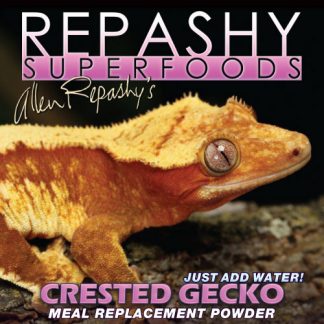This Crested Gecko care sheet, or any others, shouldn’t be taken as gospel. If you ask 10 different breeders how they keep their animals, you will get 11 different answers. This care sheet comes from the evolution of how I have kept geckos over the last 10 years. I encourage all keepers to read as many care sheets/guides as they can and try different ideas and techniques until they find the best combination for themselves.
Feeding
Crested geckos are omnivorous animals. You can feed dusted crickets, mealworms, wax worms, roaches, etc. Crested geckos also eat commercially produced diets. Groveland Gecko animals are fed on Repashy. Both the Crested and day gecko formula are the same, the flavoring is different.
Geckos should be fed 2-3 times per week as babies and 1-2 as adults. You want to feed them only what they will eat in 24-48 hrs. Loose insects can stress and attack the geckos (especially concerning for babies) and the diet can mold and grow bacteria.
-
Repashy Crested Gecko Diet (CGD) MRP
$10.00 – $106.00 -
Repashy Crested Gecko Diet Classic (CGCD) MRP
$10.00 – $106.00
Housing
Crested geckos should be housed in appropriate sized cages. Babies should be kept in smaller containers, so they feel secure and can easily find food. Babies at Groveland Gecko are kept in 20qt sterilite containers (8”hx16”dx10”w). Similar sized containers (exo Terras, kritter keepers, Acylic cages, etc) should be used with a food and water dish, fake or live vines/plants and something to climb on (egg cartons are used at Groveland Gecko).
Adults should be housed in larger containers. At Groveland Gecko, adult pairs are kept in 56qt sterilite containers (12”hx24”dx12”w). Popular options include exo terras, which an 18”x18”x18” would be suitable. Larger, to an extent, is always better. Too large can cause problems with the animal not able to find food and water.
Lighting
Crested geckos are nocturnal and do not appear to gain any health benefits from UVB lights. They do, however, require a day/night cycle. This can be accomplished with just natural sunlight from windows and/or artificial lights.
Temperature
Crested Geckos do best at room temperature. They thrive in the mid-70’sF. 80+F can be tolerated for short periods. At night, the temps should drop 5-8 degrees to reinforce the day/night cycle. Artificial heat may be needed in the winter, depending on your location. This can be achieved with either a light (red/black preferably) and/or heat tape. Make sure your animal does not come in direct contact with the heat source. Lights should be mounted outside the cage or have a guard installed. Heat tape should be installed under the tank (please read the manufactures instructions to ensure adequate airflow).
If possible, a temperature gradient is always best. This would mean heating one side of the cage, so the animal can choose what temperature it prefers.
-
Digital Infrared Thermometer DT300
$15.00 -
Digital Probe Thermometer
$5.00 -
Mini Infrared Thermometer
$10.00
Humidity
Crested geckos need some humidity to shed, but they are not from the tropics. Typically, 50-60% humidity is good with 1-2 mistings a day to increase the humidity to 75-80%. This should be allowed to dry out to the normal 50-60%. To ensure your animals are always property hydrated, a water dish can be used and a wet/moise hide. The hide can be as simple as a sterilite (or similar) sandwich container filled with wet moss or coconut fiber.
Breeding
**Before you decide to attempt to breed geckos, or any animals, you should always remember you will need to care for any animals you produce.
Sexing
For breeding, you will obviously need to start with a pair of geckos (one male and one female). Males have a large hemipene bulge at the base of their tail near the cloaca and females do not. Males will also have pre-anal pores, whereas females don’t. Pores can typically be seen at 6-8 months, though this method cannot be used 100% of the time. I have had animals that look female until 12-18 months before it becomes obvious.
Eggs
You will want to add in a humid lay box. If you are using a humid hide for a single animal, this can double as a lay box. If you use a substrate throughout the cage, the female may lay there rather than in the egg box. I do not use any substrate and have a lay box. Occasionally a female laying her first clutch will drop them randomly in the cage, but this is rare.
Crested Geckos will lay 2 eggs in a clutch and will do so about once a month. They will lay 6-8 clutches in a season. The first few clutches may only be one egg.
Incubation
Eggs should be incubated at 70-75F. A long duration above 80F can be fatal to the eggs. Eggs will typically take 60-90 days to hatch. I prefer to incubate around 73F, which takes close to 90 days to hatch. Longer incubation times will produce stronger hatchlings. Unlike Leopard Geckos, Crested eggs do not appear to be temperature sex determinate. Some breeders report lower temperatures correspond to higher rates of females, but I have not hatched out enough animals to confirm or deny this.
Babies
Babies are fairly straight forward, as I keep them the same as adults, just on a smaller scale. I do not use substrate with babies to avoid impactation (debris become lodged in their digestive track). You do want to keep them a little wetter than adults to aid in shedding. Babies won’t eat before their first shed, which typically takes 3-5 days from hatching.






